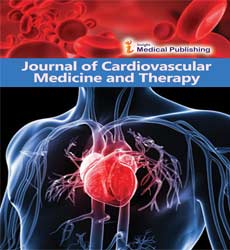The statins in preventive cardiology
Jenny cat
Department of Cardiovascular Medicine and Therapy, Cairo University, Egypt
- *Corresponding Author:
- jenny cat
Department Cardiovascular Medicine and Therapy, Cairo University, Egypt
Tel: 7075814290
E-mail: jennycat2121@gmail.com
Received Date: December 03,2021; Accepted Date: December 16,2021; Published Date: December 23,2021
Citation: Cat J (2021) The statins in preventive cardiology. J Cardiovasc Med The Vol:4 No:3
Short Communication
The International Journal of Cardiology (IJC) is one of the most prestigious and well-established original research journals in cardiovascular medicine. In the 2011 Thomson ISI journal rankings, it is ranked 6th out of 114 journals in the category by impact factor. Since the formation of IJC in 1983, the scientific literature in cardiology has raised at an exponential rate, from 274 papers in PubMed searchable by the keyword "Cardiology" in 1983 to 11,640 papers in 2010, a 42-fold increase. The number of articles submitted to the IJC has risen from 250 to 4,000 each year in a decade, representing an incredible 35 percent yearly growth rate. In the last decade, cardiac magnetic resonance imaging (MRI) and computed tomography (CT) have advanced quickly. Because of advancements in technology and the widespread availability of current CT and MRI scanners, both diagnostic modalities are being used more frequently in clinical practise.
As a result, the German Cardiac Society, German Radiology Society and German Society for Pediatric Cardiology collaborated to create this German consensus paper. It is focused on illness entities rather than techniques and approaches. Coronary artery disease, cardiomyopathies, arrhythmias, valvular disorders, pericardial diseases and structural abnormalities, as well as congenital heart anomalies are all included in this consensus statement. CT and MRI imaging modalities are contrasted and evaluated in the context of various clinical circumstances. Over VHS, digital echocardiography has various advantages, including ease of review, comparison, storage, post-processing, and sharing of studies, quantitative analysis and greater resolution. Older echocardiogram systems require the digitalization of analogue data, but newer systems can write digital data to computer hardware. To reduce research size, clinical and digital data compression is essential. Clinical compression has been proven in a number of adult and paediatric trials. The digital compression ratios of JPEG and MPEG, which are 26:1 and 200:1, respectively, are comparable to S-videotape quality. Short loops, serial comparisons and quantitative analysis are excellent for JPEG, which is the DICOM 3.0 standard. MPEG (the motion picture standard) lends itself to video stream digitization, which may appeal to paediatric cardiologists.
Data storage and transfer options range from a single offline review station to several offline review stations connected by a wide-area network. In a "save and forward" or "real-time" mode, telemedicine extends the capabilities of digital echocardiography. Neonatal telecardiology in real time is accurate, has a positive influence on patient care, is cost-effective and does not raise utilisation. Cost a greater reliance on sonographers' abilities, a lack of established standards, as well as legal, licensure and billing concerns are all barriers to widespread use of digital echocardiography and telemedicine. Since December 2019, the Coronavirus Disease 2019 (COVID-19) has caused significant morbidity and mortality around the world. However, there is a scarcity of data on cardiac damage in COVID-19 patients. Data from the clinical laboratory, radiology and treatment were gathered and examined. Patients with and without cardiac damage had their outcomes compared. The link between heart damage and death was investigated. Cardiac damage is a prevalent complication among COVID-19 patients in Wuhan, China and it is linked to an increased risk of in-hospital mortality.
References
- Shewan L (2011) Statement on authorship and publishing ethics in the international journal of cardiology, IJC 153:239-240
- Achenbach S (2012) Consensus recommendations of the German Radiology Society (DRG), the German Cardiac Society (DGK) and the German Society for Pediatric Cardiology (DGPK) on the use of cardiac imaging with computed tomography and magnetic resonance imaging. Rofo 184:345-368
- Sable C (2002) Digital echocardiography and telemedicine applications in pediatric cardiology. Pediatric Cardiology 23:358-369
- Shaobo S (2020) Association of Cardiac Injury With Mortality in Hospitalized Patients With COVID-19 in Wuhan. JAMA Cardiology 5:802-810
Open Access Journals
- Aquaculture & Veterinary Science
- Chemistry & Chemical Sciences
- Clinical Sciences
- Engineering
- General Science
- Genetics & Molecular Biology
- Health Care & Nursing
- Immunology & Microbiology
- Materials Science
- Mathematics & Physics
- Medical Sciences
- Neurology & Psychiatry
- Oncology & Cancer Science
- Pharmaceutical Sciences
